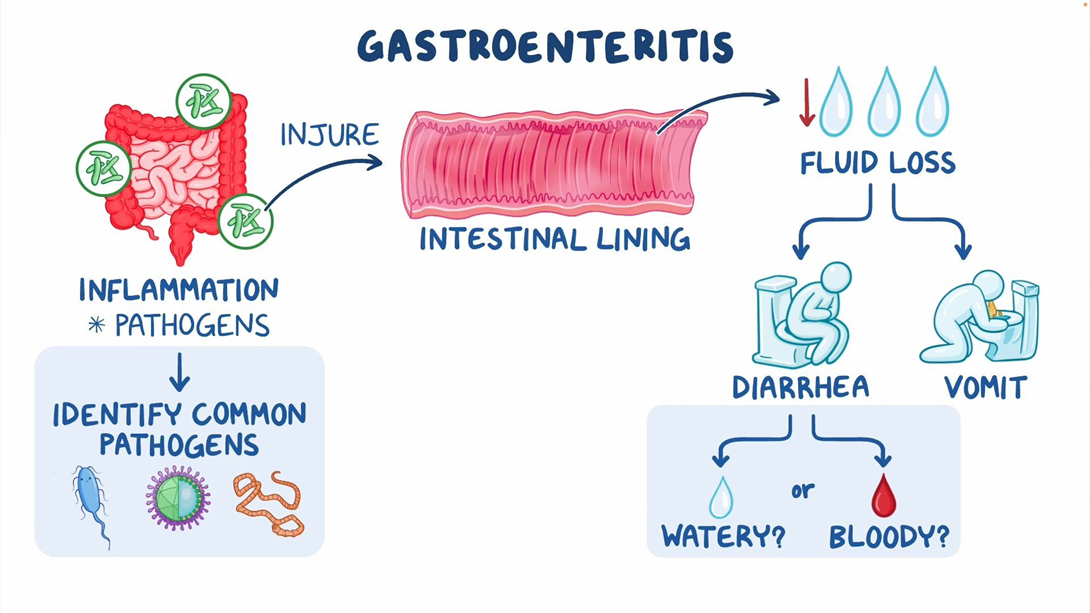A nurse in a clinic is caring for a client who has gastroenteritis. The nurse compares the client's condition from two days ago and today. Which of the following changes should the nurse report to the provider?
The client is confused and appears weak.
The client's oral mucosa is dry and tongue is furrowed.
The client's lungs are clear bilaterally.
The client's abdomen is soft and nontender.
The Correct Answer is A
Choice A reason: Confusion and weakness are signs of dehydration and electrolyte imbalance, which can result from vomiting and diarrhea. These are serious complications that can affect the client's mental status, blood pressure, heart rate, and kidney function. The nurse should report these changes to the provider and monitor the client's vital signs and fluid status.
Choice B reason: Dry oral mucosa and furrowed tongue are also signs of dehydration, but they are less severe than confusion and weakness. The nurse should report these changes to the provider as well, but they are not the most urgent ones.
Choice C reason: Clear lungs bilaterally are a normal finding and do not indicate any change in the client's condition. The nurse should document this finding, but it does not require reporting to the provider.
Choice D reason: A soft and non-tender abdomen is a normal finding and does not indicate any change in the client's condition. The nurse should document this finding, but it does not require reporting to the provider.

Nursing Test Bank
Naxlex Comprehensive Predictor Exams
Related Questions
Correct Answer is A
Explanation
Choice A reason: Elevating the head of the client's bed can help prevent aspiration and facilitate swallowing. The nurse should keep the client's head elevated at least 30 degrees during and after feeding, and check for signs of aspiration, such as coughing, choking, or wheezing.
Choice B reason: Using a syringe to give the client fluids is not a safe method, as it can cause the fluids to enter the airway too quickly and cause aspiration. The nurse should use a spoon or a cup to give the client fluids, and thicken them if needed to make them easier to swallow.
Choice C reason: Instructing the client to chew on the left side of their mouth is not a good idea, as the left side is paralyzed and has reduced sensation. The client may not be able to chew or feel the food on that side, and may accidentally bite their tongue or cheek. The nurse should instruct the client to chew on the right side of their mouth, which is unaffected by the stroke.
Choice D reason: Instructing the client to swallow with their head tilted back is not a good practice, as it can open the airway and allow food or liquid to enter the lungs. The nurse should instruct the client to swallow with their head tilted slightly forward, which can close the airway and direct the food or liquid to the esophagus.
Correct Answer is A
Explanation
Choice A reason: A low-protein diet is essential for clients who have PKU, as they cannot metabolize the amino acid phenylalanine. High levels of phenylalanine can cause intellectual disability and other neurological problems. A low-protein diet should be started before pregnancy and maintained throughout pregnancy to prevent fetal harm.
Choice B reason: Serum bilirubin is not related to PKU. It is a product of red blood cell breakdown and is elevated in conditions such as jaundice, liver disease, or hemolytic anemia. It does not need to be monitored routinely in clients who have PKU.
Choice C reason: Diet sodas are not recommended for clients who have PKU, as they often contain artificial sweeteners such as aspartame, which is a source of phenylalanine. Diet sodas should be avoided completely or consumed very sparingly by clients who have PKU.
Choice D reason: Breastfeeding will not prevent the baby from developing PKU, as PKU is a genetic disorder that is inherited from both parents. If both parents have PKU, the baby will have a 100% chance of having PKU. If one parent has PKU and the other is a carrier, the baby will have a 50% chance of having PKU. If one parent has PKU and the other is not a carrier, the baby will not have PKU but will be a carrier. Breastfeeding may provide some benefits for the baby, such as immunity and bonding, but it will not affect the baby's PKU status.
Whether you are a student looking to ace your exams or a practicing nurse seeking to enhance your expertise , our nursing education contents will empower you with the confidence and competence to make a difference in the lives of patients and become a respected leader in the healthcare field.
Visit Naxlex, invest in your future and unlock endless possibilities with our unparalleled nursing education contents today
Report Wrong Answer on the Current Question
Do you disagree with the answer? If yes, what is your expected answer? Explain.
Kindly be descriptive with the issue you are facing.
